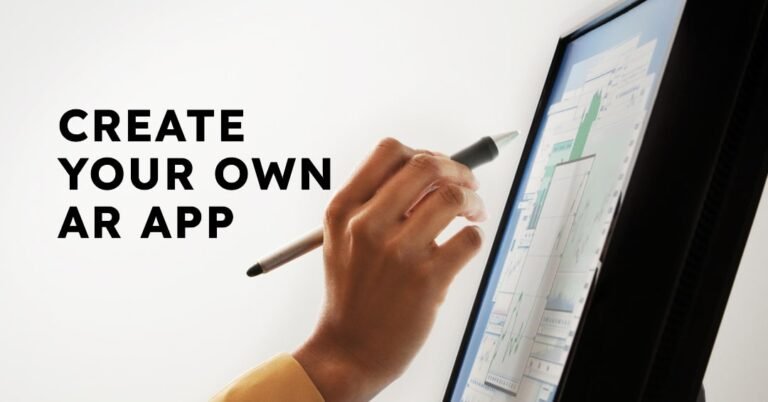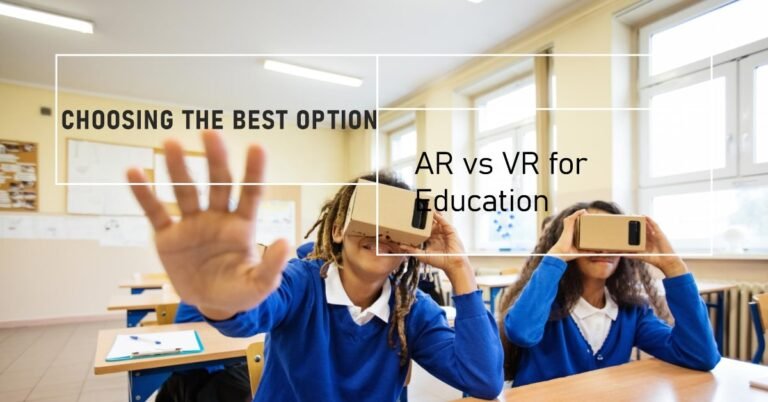The Ultimate Guide to AR in Education – What’s Next?
Imagine a classroom where students can dissect a virtual frog, explore the pyramids of Giza without leaving their desks, or witness the birth of a star system firsthand. This isn’t science fiction! This is the transformative power of Augmented Reality (AR) in education, rapidly changing how we learn.
The Ultimate Guide to AR in Education: What’s Next? explores the exciting potential of AR, offering educators a roadmap to navigate this innovative learning landscape. We’ll delve into the “what” and “why” of AR in education, showcase real-world examples, and explore the challenges and opportunities that lie ahead. So, grab your metaphorical headset, and let’s embark on this journey together!
What is AR and How Does it Work in Education?
AR in a nutshell: Imagine a world where digital information seamlessly blends with the physical environment. That’s AR! It uses a smartphone, tablet, or headset to overlay computer-generated graphics, animations, and 3D models in the real world in real-time.
The magic of AR in education: Here’s how AR breathes life into learning:
- Interactive 3D models: Students can manipulate 3D models of historical landmarks, dissect virtual organisms, or hold the planets in their hands – all within the classroom.
- Contextual learning: AR overlays information onto real-world objects, creating an immersive learning experience. Imagine students pointing their tablets at a painting in an art museum and learning about the artist, techniques, and historical context.
- Gamification: AR games can transform learning from rote memorization to an engaging adventure. Imagine students solving math problems by defeating virtual monsters or learning languages through interactive AR simulations.
What does AR mean in teaching?
It’s a technology that overlays computer-generated graphics, animations, and 3D models on the real world in real-time, typically using a smartphone, tablet, or headset.
Imagine a student pointing their tablet at a picture in a history book and seeing the historical scene come alive in 3D! That’s the power of AR in education.
It can revolutionize learning by making it more:
- Interactive: Students can manipulate 3D models, explore virtual environments, and engage with learning in a whole new way.
- Contextual: AR overlays information onto real-world objects, creating a deeper connection between what students are learning and the world around them.
- Engaging: AR games and simulations can transform learning from rote memorization to an exciting adventure.
Why do we use AR in education?
We use AR in education for a multitude of reasons, all geared toward making learning more effective and engaging for students. Here’s a breakdown of the key benefits:
Boosts Engagement and Motivation:
Traditional learning methods can sometimes feel flat. AR injects excitement by bringing lessons to life in an interactive way. Imagine dissecting a virtual frog in biology class or exploring the pyramids of Giza virtually during a history lesson. This interactive and immersive nature of AR captures students’ attention and makes them active participants in their learning journey.
Improves Knowledge Retention:
AR excels at visualizing complex concepts. Whether it’s a 3D model of a molecule or a simulation of a historical event, AR helps students grasp information in a way that static textbooks and lectures often can’t. This deeper understanding translates to better knowledge retention in the long run.
Caters to Diverse Learning Styles:
Not all students learn the same way. AR caters to this by offering a variety of learning experiences. Visual learners benefit from 3D models and animations, auditory learners can leverage AR’s sound effects and narration, and kinesthetic learners can interact with the virtual elements, making learning more inclusive and effective for all.
Provides Contextual Learning:
Textbooks can feel disconnected from the real world. AR bridges this gap by overlaying information onto real-world objects. For instance, students can point their tablets at a painting in an art museum and learn about the artist, techniques, and historical context. This contextual learning helps students make connections between what they’re learning and the world around them.
Enhances Accessibility:
AR has the potential to make learning more accessible for students with disabilities. For example, AR apps can provide audio descriptions of visuals for visually impaired students or offer alternative text formats for those with reading difficulties.
Breaks Down Physical Barriers:
AR can transport students anywhere in the world, or even beyond! Imagine a virtual field trip to the Great Barrier Reef or a journey through the human body. This allows students to experience things that might not be possible in a traditional classroom setting, making learning more accessible and inclusive.
Enhances Understanding and Retention:
Textbooks and lectures can only go so far. AR’s ability to visualize complex concepts in 3D can lead to a deeper understanding. For instance, students can explore the inner workings of a cell or manipulate a 3D model of the solar system. This visual reinforcement helps solidify information in students’ minds, leading to better knowledge retention.
Overall, AR in education is a powerful tool that can transform the way we learn. It fosters engagement, improves knowledge retention, caters to diverse learning styles, and makes learning more contextual and accessible. As AR technology continues to evolve, we can expect even more exciting possibilities to emerge in the classroom.

What is an example of AR learning?
Here’s an example of AR learning to bring a history lesson to life:
Imagine a class studying ancient Egypt. Traditionally, they might pore over textbooks filled with pictures and hieroglyphics. But with AR, the learning becomes much more interactive and engaging.
The teacher could use an AR app that allows students to point their tablets at a picture of the Great Pyramid of Giza in their textbook. Suddenly, the picture comes alive! Students can see a 3D model of the pyramid rise from the page, complete with realistic textures and details. They can zoom in and explore different sections, perhaps even virtually “walking” around the base.
The AR app might also overlay informational hotspots on the 3D model. By tapping on these hotspots, students can access additional information about the pyramid’s construction, purpose, and historical significance. Perhaps they can even hear narrated snippets from ancient Egyptians describing the building process.
This AR experience transforms a static image into a dynamic and engaging learning tool. Students can visualize the scale and grandeur of the pyramid in a way that a textbook picture simply cannot achieve. They can also learn more about its history in a way that’s both fun and memorable.
This is just one example, of course. AR can be used to enhance learning across a wide range of subjects, from science and geography to literature and language arts. The possibilities are truly endless!
The Ultimate Guide to AR in Education: Real-World Examples
AR is no longer a futuristic concept. Here are a few examples of how educators are already using AR to revolutionize learning:
- History comes alive: Imagine students walking through ancient Rome with the Colosseum virtually reconstructed before them, complete with sounds and animations. This is the experience offered by apps like “Littlest Romans.”
- Science in action: “Merge Cube” is a physical cube that comes alive with AR, allowing students to interact with 3D models of molecules, cells, or even the solar system.
- Language learning gets real: Apps like “Quiver” bring flashcards to life with interactive 3D animals or objects, making language learning for young children more engaging and memorable.
These are just a few examples, and the possibilities are truly endless!
How can teachers use AR in the classroom?
Teachers have a treasure trove of ways to leverage AR in their classrooms and make learning an exciting adventure! Here are some ideas to get you started:
1. Bring Textbooks and Worksheets to Life:
- Static diagrams and historical figures in textbooks can become interactive experiences with AR. Imagine students scanning a picture of the human heart and witnessing a 3D model come alive, complete with labeled chambers and a pulsating animation.
- AR apps can also transform worksheets into interactive games. Math problems can morph into battles with virtual monsters, vocabulary lessons can involve collecting AR flashcards with 3D objects, and science experiments can be visualized through interactive simulations.
2. Immerse Students in Virtual Field Trips:
- Field trips can be expensive and logistically challenging. AR eliminates these barriers! Imagine a virtual tour of the pyramids where students can explore the tombs and learn about hieroglyphics.
- Travel the world with AR apps that showcase different ecosystems, historical landmarks, or even the wonders of the solar system – all from the comfort of the classroom.
3. Foster Collaboration and Inquiry-Based Learning:
- AR experiences can be designed for group work. Imagine students collaborating on a virtual project like building a 3D model of a historical city or recreating a scientific experiment through an AR simulation. This fosters teamwork, communication, and critical thinking as students work together to solve problems and explore concepts.
4. Enhance Student Understanding and Retention:
- Complex scientific concepts like molecular structures, cellular processes, or historical battles can be visualized in 3D with AR, allowing students to manipulate and explore them from different angles. This visual reinforcement helps solidify information and leads to better knowledge retention.
5. Cater to Diverse Learning Styles:
- Not all students learn the same way. AR caters to this by offering a variety of learning experiences. Visual learners can benefit from 3D models and animations, auditory learners can enjoy narrated content, and kinesthetic learners can get hands-on with interactive simulations. This multi-sensory approach ensures all students can learn effectively based on their preferred learning style.
Remember:
- Explore Existing Resources: Websites like ARVRRealm.com offer a wealth of free and paid AR apps and resources specifically designed for educators.
- Consider Cost and Accessibility: While AR offers immense benefits, keep in mind the cost of devices and potential limitations for students from different backgrounds.
- Plan for Integration: Don’t just jump into AR for the sake of it. Carefully consider how AR can enhance your existing curriculum and learning objectives.
By incorporating AR strategically, teachers can create a more engaging, interactive, and effective learning environment for all their students. So, why not give it a try and see the magic of AR unfold in your classroom?

The Ultimate Guide to AR in Education: Challenges and Opportunities
As with any new technology, AR in education faces some challenges:
- Cost and accessibility: AR headsets and other hardware can be expensive, creating an access gap between schools with different financial resources.
- Content creation: Developing high-quality, curriculum-aligned AR content requires expertise and resources that may not be readily available to all educators.
- Integration with existing curriculum: Integrating AR effectively requires thoughtful planning and a shift in teaching methods to make the most of this technology.
However, the opportunities AR presents far outweigh the challenges:
- Personalized learning: AR can cater to different learning styles by offering visual, auditory, and kinesthetic learning experiences.
- Increased engagement: AR’s interactive nature can significantly boost student motivation and participation.
- Improved knowledge retention: AR’s ability to visualize complex concepts can lead to deeper understanding and better knowledge retention.
The Ultimate Guide to AR in Education: A Glimpse into the Future
So, what’s next for AR in education? Here are some exciting possibilities on the horizon:
- Standardized AR platforms: Imagine a future with standardized AR platforms that allow educators to easily create and share high-quality AR content.
- AR wearables become mainstream: As AR technology becomes more affordable and accessible, we can expect the rise of comfortable and user-friendly AR wearables specifically designed for education.
- AI-powered AR experiences: Imagine AI that personalizes AR experiences based on individual student needs and learning styles.
These are just a few possibilities, and the future of AR in education is brimming with potential.
AR in Education FAQs
Here are some frequently asked questions about Augmented Reality (AR) in education:
What are the benefits of AR in education?
Increased engagement and motivation: AR’s interactive nature makes learning more fun and exciting.
Improved understanding and retention: AR helps visualize complex concepts, leading to deeper learning.
Caters to diverse learning styles: AR offers visual, auditory, and kinesthetic learning experiences.
Promotes collaboration and inquiry-based learning: AR can be used for group projects and problem-solving activities.
Breaks down physical barriers: AR allows virtual field trips and exploration of distant locations.
What are some examples of AR learning?
Bringing textbooks to life with 3D models and interactive overlays.
Taking virtual field trips to historical landmarks or natural wonders.
Dissecting virtual frogs or manipulating 3D models of molecules in science class.
Making language learning more engaging with interactive AR flashcards.
How can teachers use AR in the classroom?
Use AR apps to make textbooks and worksheets interactive.
Take students on virtual field trips without leaving the classroom.
Design AR projects that encourage collaboration and critical thinking.
Utilize AR to visualize complex concepts and enhance understanding.
Integrate AR activities that cater to different learning styles.
What are some challenges of using AR in education?
Cost and accessibility: AR headsets and devices can be expensive.
Content creation: High-quality, curriculum-aligned AR content creation requires expertise and resources.
Integration with existing curriculum: Implementing AR effectively requires thoughtful planning and adjustments to teaching methods.
Where can I find AR resources for education?
Websites like ARVRRealm.com offer a wealth of free and paid AR apps and resources specifically designed for educators.
What’s the future of AR in education?
Standardized AR platforms for easy content creation and sharing.
Affordable and user-friendly AR wearables designed for education.
AI-powered AR experiences that personalize learning for each student.

Conclusion – A Gateway to a Brighter Future
The world of education is on the cusp of a transformation, and Augmented Reality (AR) stands at the forefront. This powerful technology is no longer science fiction; it’s a reality with the potential to revolutionize the way we learn.
AR in education is more than just a fancy gimmick. It’s about creating an engaging, interactive, and immersive learning experience that caters to all students. By bringing textbooks to life, facilitating virtual field trips, and visualizing complex concepts, AR can spark a love for learning and unlock a world of possibilities.
While challenges like cost, accessibility, and content creation exist, the potential benefits far outweigh them. As AR technology continues to evolve and becomes more affordable, we can expect to see standardized platforms, user-friendly wearables, and AI-powered personalization become commonplace in classrooms.
The future of AR in education is bright. Imagine a classroom where students are no longer passive learners but active explorers, manipulating 3D models, collaborating on virtual projects, and embarking on journeys of discovery – all within the walls of their classrooms.
Are you ready to embrace AR in your classroom? The resources and tools are readily available. Explore existing AR apps, consider how AR can enhance your curriculum, and take that first step toward a more engaging and effective learning environment. After all, the future of education is augmented, and it’s an exciting future to be a part of.






